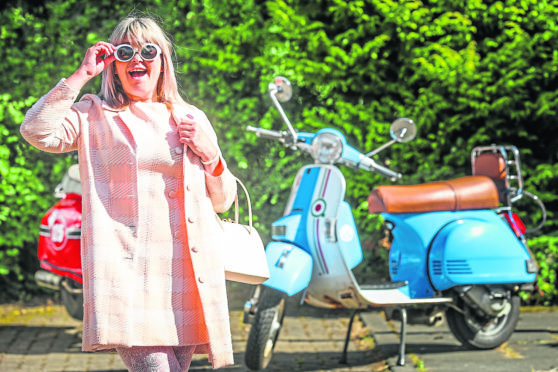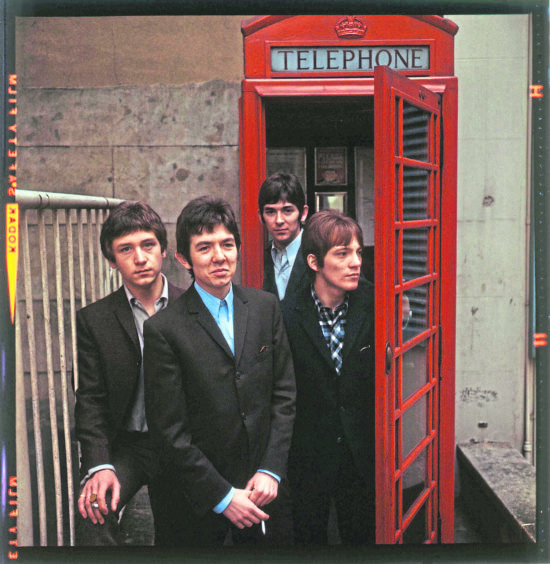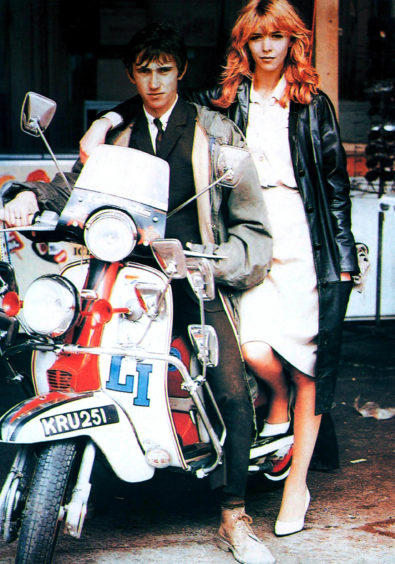
With a new Paul Weller album topping the charts and an unofficial sequel to classic movie Quadrophenia due, the mod movement is undergoing one of its regular revivals.
But, for fans of the music and the style, mod never went away. In a recent interview, the former Jam frontman insisted: “I’m still a mod, I’ll always be a mod, you can bury me a mod” and his words could equally apply to grandmother Eve DePonio, from Glenrothes, one of Scotland’s most ardent mods.
She owns two copies of Weller’s latest album, On Sunset, and is aiming to see To Be Someone, the forthcoming mod drama movie featuring Phil Daniels and Leslie Ash, who also starred in Quadrophenia, when it’s released.
The 51-year-old has, since she was 14 (barring a break to raise a family), been a proud mod and, she believes, the movement is more vibrant and diverse than ever. “There are so many more young ones getting involved now,” she said. “In the late-1970s there was a mod revival and it seems to be the children of those mods who are getting involved these days.
“Then you’ve got younger ones who seem to love it. I went into town on my scooter recently and a group of teenagers were telling me how much they wanted one too. It’s pan-generational. There are people old enough to be my parents who are still in the scene – they’re turning up looking absolutely impeccable, so sharp – with scooters from the 1960s.
“The mod pages on Facebook are getting very popular these days, which is encouraging for us.”
So mods have gone from Small Faces to Facebook. And it’s not the only change. Eve has been driving a scooter since she was 16. These days she owns two – her favourite being an LML Auto, which is a copy of the classic Italian Vespa PX.
Civil servant Eve has been joined by other female mods, and is encouraged to see more. “If women were on scooters in the original Mod scene, then they tended to be on the back, holding on to the men,” she said. “They were seen as a boy’s thing. Nowadays we’ve all got our own.
“There are people my age and they take their kids on the back of the scooter. And there’s a lot more availability around things you can buy. I got my daughter a toy Vespa scooter when she was younger, and my granddaughter a Fred Perry jacket more recently. My youngest grandson is wearing Ben Sherman shirt with the RAF roundel on. You can’t help but pass these things on.”
Dressing impeccably – in bespoke Italian fashion, Harrington jackets and Chelsea boots, for instance – is now not just about looking as if you’re both cutting-edge and part of the scene, it’s also a way to bond with family members.
David Dee of Glasgow clothing shop Dee’s of Trongate said: “What we’ve noticed now is the guys coming in for this type of gear. Now grandfathers, they’re bringing their children and grandchildren in, immersing them in the mod scene.”
His grandfather, also David, opened the shop in 1963 and it has since specialised in mod clothing. David, 21, has been steeped in the style, man and boy. “I’ve got the Doc Martens, the Harringtons, the parkas, the polos – I dress that way too,” he said. “I remember being in the shop when I was wee. I saw these sharp-looking guys coming in. They dressed like that.
“You tend to dress like the people you see every day. I even had the kiddies’ Docs when I was a boy. My parka is my most prized possession.”
Recently, David looked at ordering Paisley-pattern masks but decided against it. Perhaps it seemed too silly for a group that takes its fashion – and its music – seriously.
One thing that hasn’t changed is how mods have retained their impeccable standards. The scene definitely isn’t about being stuck in the past, according to perhaps Scotland’s foremost mod, Paul Molloy.
He runs mod club night Tailor Made with Mikey Collins.
The movement may have at times been associated with 1960s fashion – but the idea makes Paul, 50, a painter from Glasgow, wince.
Mods were originally considered a cutting-edge movement and Paul, who has been a mod since he was a teen being chased round Glasgow by skinheads, wants to retain that quality. “If you’re just listening to Louie Louie, driving about with a parka with a Union Jack on the back on a scooter with loads of mirrors on it then it’s more about being in a re-enactment society than being a mod,” he explained.
“You might as well dress up like these guys who pretend they’re fighting at Bannockburn. If you want to do that then fair enough, but to me that’s not what the scene is about.”
Paul’s massive record collection has seven-inch singles ordered from the internet arriving at his door almost daily. It’s an expensive habit which he admits needs smoothed over with the wife.
It’s worth it to stay ahead of the curve – which has moved beyond the Small Faces. One of Paul’s favourite acts is Bristol group The Allergies, who use samples, drum machines – and even rapping.
“They have rappers on their tracks – some guys on the scene would be horrified at playing a track with rap on it. But if it’s good, it’s good.
“We’re always discovering new music. To me if you’re not playing current sounds then you’re just becoming a sort of sad retro scene. If it sounds right, then it deserves to get played. It’s about finding the best of what’s new, and cherry-picking what’s out there already.”
For Eve, and her LML Auto, being a mod is about belonging to a group – as well as standing out.
“Everybody’s encouraging,” she said. “As a teenager you got negative comments – but you’d have comments made by the punks and skinheads. These days people will mainly say nice things about your clothes and your scooter.
“You stop at the traffic lights on your scooter, wearing your full mod outfit and have someone double-take you. See that feeling? There’s nothing like it.”
Peter Meaden, The Who’s manager, described being a mod as “clean living under difficult circumstances”.
Perhaps it’s no wonder the movement is making a comeback in a year where circumstances have been very difficult. Originating in post-war London, the movement was made up of young, working-class men united by a love of jazz and soul music, bespoke Italian suits and scooters.
The subculture was associated with ’60s rock acts including The Who and Small Faces, but it was the clashes with rival rockers that dominated headlines. In the late-1970s the mod scene experienced a revival, with groups like The Jam, led by arch-Mod Paul Weller, appearing and the movie Quadrophenia being released. In the ’90s another mod wave hit the UK during the Britpop era with Oasis and Blur at the forefront.
The classic sounds and styles that define the mod scene
The Tunes
Green Onions – Booker T and the Mgs
This iconic R&B instrumental track was released in 1962 but became a UK top 10 hit 18 years later after featuring on The Who’s Quadrophenia soundtrack.
Come See About Me – Nella Dodds
Written and produced by the Motown team of Eddie Holland, Lamont Dozier and Brian Holland for The Supremes, the Nella Dodds version is a mod classic.
What’Cha Gonna Do About It – Small Faces
The debut single for Steve Marriott and Ronnie Lane’s Small Faces was the American R&B sound as interpreted by a 60s British rock group.
My Generation – The Who
The quintessential song about youthful rebellion was a hit for The Who in 1965. Pete Townsend said the track was about “some pilled-up mod dancing around, trying to explain to you why he’s such a groovy guy, but he can’t because he’s so stoned he can hardly talk.”
A Town Called Malice – The Jam
The Modfather Paul Weller’s group The Jam’s single was a nod to the singer’s teen years growing up in Woking as a fan of The Small Faces.
The Togs
Green fishtail parka
Sported by the likes of Phil Daniels in Quadrophenia and Liam Gallagher in the 90s, the iconic green parka is a must have for those Brighton-bound on a scooter.
Bass Weejuns
Originally made popular by Norwegian fishermen, the hand-stitched leather and hard-wearing soles of these loafers are invaluable on any Northern Soul dance floor.
Short Shift Dress
The classic mod dress comes in either a bold colour with geometric shapes, or black and white with optical patterns. Peter Pan collar a must.
Fred Perry polo shirt
Want to look stylish but feel comfortable enough to dance all night to classic R&B tracks? Classic mods often favoured a smart Fred Perry polo.
Ben Sherman shirt
Smart shirts were favoured by the US jazz musicians idolised by mods, and Ben Shermans became the first choice in the scene. Don’t forget the classic RAF roundel.

Enjoy the convenience of having The Sunday Post delivered as a digital ePaper straight to your smartphone, tablet or computer.
Subscribe for only £5.49 a month and enjoy all the benefits of the printed paper as a digital replica.
Subscribe © Sunshine International/Shutterstock
© Sunshine International/Shutterstock © Curbishley-Baird/Kobal/Shutterstock
© Curbishley-Baird/Kobal/Shutterstock